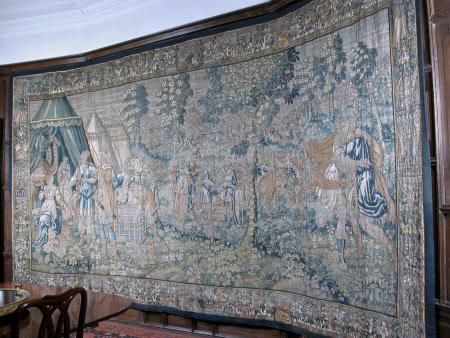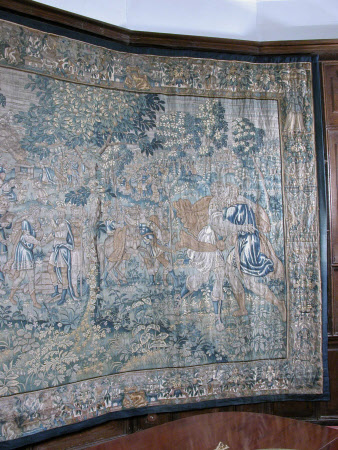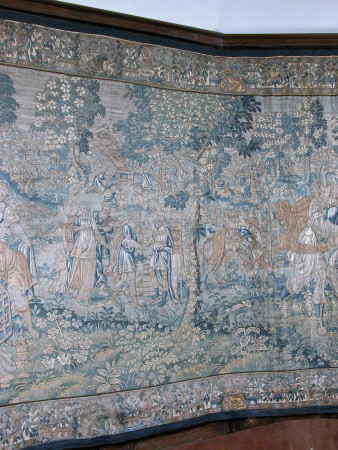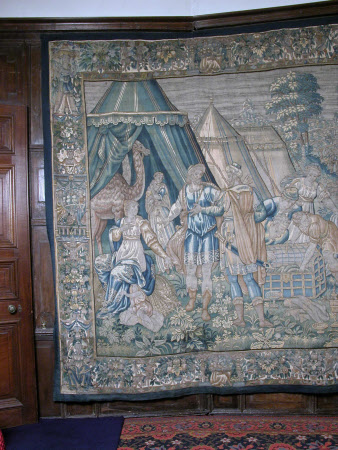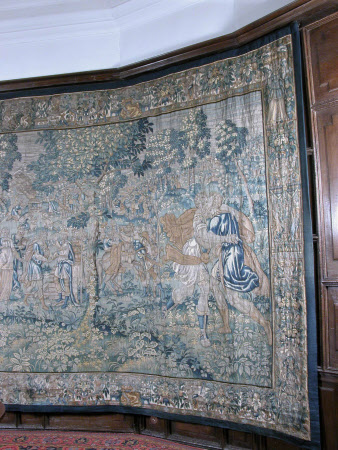Laban Searching for the Idols and the Meeting of Jacob and Esau
Flemish
Category
Tapestries
Date
circa 1550 - circa 1600
Materials
Tapestry, wool and silk, 5 warps per cm
Measurements
3200 x 5350 mm
Order this imageCollection
Powis Castle and Garden, Powys
NT 1181016
Summary
Tapestry, wool and silk, 5 warps per cm, Laban Searching for the Idols and the Meeting of Jacob and Esau from a set of four of The Story of Jacob, Southern Netherlands, c. 1550-1600. A landscape with two principal figure groups in the foreground and a number of smaller figure groups in the background. On the left is Jacob’s camp, with Jacob and Laban standing in conversation in the foreground while Laban’s men search Jacob’s baggage, looking for the Gods that have been stolen from Laban’s house. Rachel sits on the camel’s saddle in which she has hidden the Gods (Gen. 31:25-37). The woman standing in a tent in the background may be Leah, Jacob’s other wife. The camp is surrounded by flocks of sheep, and above and to the right is a small scene of armed men travelling on camels which represents Laban and his men following Jacob. In the centre of the tapestry in the mid-ground Jacob and Laban appear again making a covenant, Laban’s men building a pillar of stones and Rachel, Leah and their handmaidens looking on, while behind this is an even smaller group showing Jacob’s family making a sacrifice at the pillar (Gen. 31:44-54). The second large foreground scene on the far right hand side shows Jacob and his twin brother Esau meeting again after twenty years and embracing (Gen. 33:4). Above and to the left of this scene Esau appears again in a small background scene at the head of a column of soldiers, speaking to Jacob’s messenger, and below this a man stands holding a leaping horse accompanied by three soldiers, representing Esau’s army waiting for him. The tapestry has borders on all four sides and bunches of fruit and flowers with small figures and scenes in between them, including figures of Fame at the lower corners, scenes with the goddess Diana hunting in the centre of the side borders, and in the upper and lower borders a man on horseback, allegorical figures of Prudence holding a snake and a mirror, Meleager killing the Caledonian Boar, a man playing a lute, and boys holding baskets of fruit.
Full description
This is the second tapestry in the 'Jacob' set Powis, and includes seven separate small scenes, Jacob himself appearing at least three times. Jacob had arrived at the house of Laban and served him for seven years for the hand of his daughter Rachel, but Laban deceived him and gave him as a wife Leah, Rachel’s older sister. Jacob was forced to serve another seven years for Rachel’s hand. Still Laban did not want him to leave, but agreed to Jacob’s suggestion that he take all the sheep and cattle that were speckled from Laban’s flock, and Jacob served another six years for the flocks. Jacob cunningly laid speckled rods before the strongest sheep and cattle to induce them to conceive speckled calves, and soon his flock had multiplied, to the anger of Laban’s own sons (Genesis 29, 30). Jacob finally determined to steal away from Laban in secret, taking his flocks and his wives with him. When they left Rachel stole the statues of Gods from her father’s house, but Jacob was unaware of this. The first scene on the left hand side of the tapestry shows Jacob’s camp, Laban and his men having caught up with them. Laban angrily demanded the return of the Gods and searched the camp, but Rachel cleverly hid them in the saddle furniture of her camel and sat upon it. Laban was also angry that Jacob had left in the night without a word, taking his daughters and his flocks, but Jacob protested that he had served for twenty years for his wives and his flocks, and that they were rightfully his. Laban was afraid of Jacob, knowing that he had God’s blessing, and the two men agreed to make a covenant that they would not harm one another. This is the small scene in the centre of the tapestry. As he approached the land of Edom, Jacob sent forth a messenger to find his brother Esau who lived there. The messenger returned and reported that Esau had 400 soldiers, which frightened Jacob so much that he split his household in two, so that if they met Esau would only be able to smite one half of it. When the two brothers finally did meet however it was a joyful reunion, “and Esau ran to meet him, and embraced him, and fell on his neck, and kissed him: and they wept.” (Gen. 33:4). This is the scene on the far right hand side of the tapestry, and above and to the left of this we see firstly Esau approaching with his army and meeting Jacob’s messenger, and then a group of Esau’s soldiers waiting with a horse. A tapestry with the same design formerly in the Swedish Royal Collection extends further on the right hand side to include a group of Jacob’s family standing behind him, and in the distance Jacob wrestling with the angel. The Swedish version has an inscription in a cartouche in the upper border which identifies the scene as follows: IACOB VIDENS SIBI FORTVNAM INVIDERI PROSPRÃ IVBETVR EI INSCIO LABAN IN TERRAM REVERTI SVAM RACHAEL FVRATVR IDDA PATRIS INSEQITVR LABAN IACOB FVGAM EI OBŸCIENS LABAN IDOLA PATRIS SIBI FVRATA QVERENS ET NON INVENIENS PACTVM FACIT CVM IACOB GENESIS CAPPITTEL .XXXI EN XXXII EN XXXIII. Jacob and his twin brother Esau were born when their parents were entering old age, having been married for twenty years. Esau was the first twin to emerge, and was hairy all over; Jacob emerged second, holding on to his brother’s heel. Esau grew up to be a hunter, but Jacob was a quiet man. Jacob bought Esau’s birthright (the right to be considered the firstborn) for a mess of pottage, and with the help of their mother Rebecca he deceived their ageing and blind father into giving him the blessing that was meant for Esau by dressing himself in goats’ skins to imitate Esau’s hairy arms. Esau was angry and resolved to kill his brother, so Rebecca arranged for Jacob to be sent away in search of a wife to the land of her brother Laban. The first tapestry in the series at Powis shows Jacob meeting Rachel, the daughter of Laban, for the first time. After serving Laban for twenty years and being deceived by him many times, Jacob finally left secretly, taking his four wives and twelve sons with him; the second tapestry shows Laban catching up with Jacob, and also Jacob meeting his brother Esau again. The third tapestry shows the rape of Dinah, Jacob’s daughter, by Shechem, an event which was followed by a bloody revenge meted out by Jacob’s sons Simeon and Levi. Jacob’s second youngest son, Joseph, was to be the next patriarch and ruler of his brethren. As a young man Joseph was sold by his brothers into Egypt, and there he rose to a position of great power; the last two tapestries are set in Egypt, where finally Jacob and the rest of his sons joined Joseph. Jacob can be recognised in each tapestry as he wears a cloak decorated with stars, in reference to Genesis 26:4, where God appeared to Isaac and said “And I will make thy seed multiply as the stars of heaven, and will give unto thy seed all these countries; and in thy seed shall all the nations of the earth be blessed.” Jacob’s twelve sons were the originators of the twelve tribes of Israel. No makers’ marks are visible on any of the Jacob tapestries (although they may be present underneath the applied edging on some of the panels). John Böttiger suggested that a related series in a Swedish private collection may have been made in the Northern Netherlands (present-day Holland) by weavers who had emigrated from the tapestry-producing lands of the Southern Netherlands in the second half of the sixteenth century. However there is nothing to suggest that this is the case, and the set was almost certainly produced at one of the weaving centres in the Southern Netherlands (roughly present-day Belgium) such as Antwerp or Oudenaarde. Böttiger dated the Swedish series to the second half if the sixteenth century and the set at Powis can be dated to the same period. A set of five tapestries after the same designs was originally in the Swedish Royal Collection at the Castle of Kungsör. The set was sold in 1892 and by 1928 one of the tapestries had disappeared, and the other four were in three separate private collections in Sweden (Böttiger 1928, pp. 35-40). The subject of the first of the Swedish tapestries, ‘Jacob gathering his Wives before Fleeing the Land of Canaan’, does not appear in the Powis set, but the other three do: ‘Laban Searching for the Idols and the Meeting of Jacob and Esau’, ‘Jacob before Pharaoh’, and ‘The Meeting of Joseph and Jacob in Egypt’. The borders of the Swedish set have a similar overall structure to the Powis set with figures and scenes arranged between bunches of flowers, but some of the figures are different, the side borders are wider, and each tapestry has a cartouche in the upper border with a long inscription describing the scene. It is possible that the series as a whole included further scenes: the important events of Jacob’s early life, including Esau selling his birthright, and Jacob stealing Esau’s blessing, appear in many other sixteenth-century tapestry sets of the ‘Story of Jacob’. The tapestries cannot be definitely identified in the 1891 inventory of Powis, but in 1908 three from the set were in their current positions in the Duke’s Room (then ‘Her Ladyship’s Sitting Room’) described as “A King seated under a canopy on Audience” (‘Jacob before Pharaoh’), “The Meeting of Jacob and Esau” (‘The Meeting of Joseph and Jacob’), and “The capture of a city and its women” (‘The Rape of Dinah’) (Knight, Frank & Rutley 1908, pp. 52-53). A description of the Duke’s Room in 1917 indicates that the tapestries were originally at Lymore, and describes them in enthusiastic terms: “the rest of the wall space [in Lady Powis’s Sitting Room – formerly the Duke’s Room] is taken up by an oak chimneypiece, by two doorways, and by a set of three sixteenth century tapestries from Lymore, the ancient home of the Herberts of Chirbury. The manner of the doorways and wall hangings is excellently shown in the illustration […], and therefore needs no further description beyond saying that much of the charm of the tapestries arises from their colouring. They were in a cut and ravelled condition, but have been perfectly repaired and are but a little faded. The general tone is blue green, that being the colour of most of the trees and landscape. This harmonises perfectly with the full indigo of some of the clothing of the figures and the green grass of some of the foliage, but in the photography the latter stands out too distinctly as dark, while the former is too pale and imperceptible” (Avray Tipping 1917, p. 139). The 1930 Powis inventory records the three tapestries in the Duke’s Room with the same titles as in 1908, and values them collectively at £350, whilst two further tapestries described as “The Parting of Abraham and Lot” (£200) and “The Meeting of Jacob and Esau” (£150) were in the Gateway Room (Supplementary Inventory 1930, pp. 1, 3). (Helen Wyld, 2010)
Provenance
Formerly at Lymore; brought to Powis Castle before 1908; accepted by HM Treasury in lieu of tax on 21 March 1963 and conveyed to National Trust ownership in 1992.
Credit line
Powis Castle, The Powis Collection (The National Trust)
Makers and roles
Flemish, workshop
References
Clive, 1930: Viscount Clive Decd. Items recommended for exemption under section 40 of the Finance act 1930, 1930 Böttiger, 1928: Johann Böttiger, Tapisseries à figures des XVIe et XVIIe siècles appartenant à des collections privées de la Suède : inventaire descriptif, 2 vols., Stockholm 1928 H Avray Tipping, ‘Powis Castle – II’, Country Life, 10 February 1917, pp. 132-9 Knight, Frank and Rutley, 1908: Messrs. Knight, Frank and Rutley, An Inventory of the Furniture and Effects at Powis Castle Welshpool, Wales. The Property of the Right Honourable the Earl of Powis. March 1908

